Depending on where you live, you may be in the midst of a fairly slow season for Flesh and Blood. Pro Quests have wrapped up and the competitive landscape of the resulting Pro Tour will be altered by the release of a new set. If you’re not attending one of the upcoming Callings, the prospect of testing new lists or refining old ones right now can seem like an inefficient use of time. However, investing time in the game is never a mistake, and if you focus your energy in the right places you can have a huge head start going into Outsiders.
The goal here is to outline how to shape your testing practices in ways you can apply right now, in order to be ready for the next big event you plan on attending.
Where to Test
The first big question is where to test? Can you stick to local Armories, or should you find a testing group? And what about the online platform Talishar? All of these have strengths - and weaknesses - to be aware of when allocating your time.
Testing Groups
There is something of a mystique surrounding testing groups. With matching shirts and buzzy names like the Wolf Pack and Arsenal Pass, competitive teams sound like something inaccessible to most people. However, a testing group is really nothing more than a group of friends who play together regularly; the prestige only follows after months and months of practice yield impressive results. This is something everyone can do in their local scenes. Go to your local game store, make some friends, and broach the topic of playing regularly - now you have a testing group.
There are many advantages to having a testing group. For instance, it allows you to field a wider range of decks. Your average collection has one or two complete decks and a binder full of cards not doing anything. In my experience with my group, we pass our unused cards and decks around all the time to experiment with new decks and test matchups, giving us a much wider perspective on the game than any one of us could achieve on our own.
The most important element is how it produces strong testing data. Playing the same opponent is one of the best ways to measure your performance. If your opponent maintains a consistent gameplan, changes in the outcome (whether it be win or loss and the margin) are more likely to be attributed to changes you make in your play or deck construction. This can give you a greater degree of confidence in your testing, saving you time.
However, there can be a pitfall in over-relying on a testing group. As you play with the same people, your play will naturally develop to exploit the unique ways in which those people play the game or build their decks. For example, it’s common knowledge in my group that I don’t run Pummel in my Rhinar deck, which means my friends never respect the option. As another example, we have so completely over-played my matchup into Dorinthea that I had over-generalized how my team played Dori to how everyone plays Dori - and lost games because of it. This is why your testing group should only be part of the process, and why local Armories are a strong complement.
Mark Chamberlain has written extensively about how to go about forming and maintaining a team in other Pro Series pieces. If you're getting serious about it, you may want to check them out, starting here.
Armories
Depending on the size of your scene, the value of local Armories for testing may vary. Sometimes I’ll go out just to find that the 50% of our local players who turned out that week are my testing group. Even still, new faces pass through all the time, making it the perfect space for putting things I’ve tested into practice. How will my opponent sideboard against me when they only know my hero? How do they react to decision forks they’ve never seen before? Will they finally respect my non-existent Pummels?
Additionally, since Armories have slightly higher stakes than playing at home, it’s a great environment for cleaning up your play. While you can ask your opponent for missed Tunic triggers (as long as you give them the same opportunity), consider holding yourself to a more rigorous standard to develop good habits. Even if it was your own choice to not ask for that missed trigger, if you lost a cold foil prize for it, the lesson is bound to stick.
Joey Senart has made a name for himself as a Flesh and Blood community-builder. If you don't have Armories running at your local store and would like to get them started, Joey's articles on generating a following are priceless.
In spite of the strengths of local Armories, the weaknesses are fairly evident. Primarily, that they are time consuming and may even cost money. In my case, I’ll leave the house at 6:30 and get back at 11:00, and I'll have spent gas + $10 to play three games of Flesh and Blood for a shot at a cold foil and store credit. This is not necessarily great value for your time. However, bundling in the social aspect and the value of just getting out of the house makes it a lot more appealing. If it weren’t for those events, I’d never have made so many great friends and valuable testing partners.
In short, be aware of what you are getting, and don’t feel pressured to go out if it doesn’t suit you. After all, there is another option.
Talishar
Talishar is the online rules enforcement engine for Flesh and Blood, the next step in community-built online play following after Tabletop Simulator. As a testing tool, it is extremely powerful: it's fast, offers a wider pool of players than any local scene, and it can be used in tandem with deckbuilding sites (like sister site FABDB) to track stats. However, it is prone to misuse and misinterpretation in multiple ways that I want to clarify.
Speed Running
Thanks to automation of shuffling and triggers, you can get in far more games of Flesh and Blood on Talishar than you would in person. Since you also don’t have to leave your house, you can easily get more games in over a week than you otherwise would in a month. On a tight testing schedule, this time compression can be essential.
However, this speed and convenience can work against you if you are not cognizant of its effects. By removing the mental load of having to manage your triggers, you may find those skills decay if you over-rely on automation. You can also get sucked into a loop where you may play many games without thinking critically. If you play games without asking yourself why you won or lost, the value of playing in the first place becomes dubious and you run the risk of burning yourself out for minimal gains. I find it is good practice to keep a diary and take short notes on one or two takeaways after each game.
Player Skill
It's a very clear positive that Talishar offers a wide breadth of opponents you can play against. At nearly any time of day, there are 40 active games and more people looking. With different populations playing at different times based on their time zones, you can find an incredible variety of decks and strategies to test against. However, this means that there is an equally wide range of skill levels, which without skill-based matchmaking can give Talishar something of a poor reputation in terms of player quality.
Both Blitz and Classic Constructed have two different queues - default and competitive. The default queue is primarily for casual play. This is an excellent space for new players and people learning new decks, but it is also rife with poor sports and quitters due to the unrestricted nature of the queue. Most people preparing for big events can be found in the competitive queue because it requires you to build a positive reputation on Talishar before you can access it. Here you will find people playing strong decks, or testing decks designed for a competitive field.
Importantly, whenever you use Fabrary’s “play on Talishar” feature to jump from a decklist right into a game, you are always anonymously placed into the default queue with no way of knowing otherwise. In order to maximize the platform, be sure to make an account on Talishar and build your reputation by playing on that account so you can use the competitive queue.
Statistics
When using your decklist on Talishar from either FABDB (instructions for jumping into Talishar with your decklist can be found here) or FABrary, your wins and losses are tracked over all matchups, as well as your play rates for cards in your deck. This kind of bulk information can be extremely powerful. For example, getting information on what cards you mostly block with can shed light on certain deckbuilding decisions. If you find yourself using a red pitch or 2 defense card to block more than you play, you should ask yourself why you’re playing it in the first place.
However, the stat collection is not perfect and can suggest misleading conclusions. The most important element is that the win/loss tracker does not distinguish between the default and competitive queues. This can trick you into perceiving a matchup as better than it may be if you split your time between both queues. You'll also find some very bizarre results on people’s decklists they share online. If a strong player unwittingly plays only on the default queue, their data can be seriously skewed and the only hint you'd have would be the suspiciously high win rate. Be careful with trusting data at face value, and ask questions about their method if it's ever unclear.
How to Test
With some primary avenues of testing explained, it's time to get into what testing actually looks like. In my experience I can break it down into three broad categories - research & development, matchup theory development, and play pattern refinement.
I view testing as a cycle of processes I move between depending on my needs. Whether I’m taking a list I found online or building one from scratch, I start with R&D, and play a wide range of matchups, taking note of things that are working and not working. Things that work form a foundation of matchup theory, and I change things that don’t work. Similarly, while developing matchup theory, I take note of the lines that work, which will then be targeted for refinement. I never really have a pure refinement phase because I simply don’t have enough time.
Despite time constraints and juggling multiple objectives simultaneously, I am always careful about how many changes I’m making. By its very nature, Flesh and Blood is a challenging game to analyze. If a new addition is a red card you frequently block with, you may be losing turn cycles in a way that is not obvious. Additionally, good science always means changing the minimal number of variables between experiments. If you try two new strategies at once, and one improves your chances and one worsens them, it can be very hard to identify what is happening. In this way, testing demands time and patience. Before committing to a testing phase, consider how much time you have and plan ahead.
Research & Development
Developing lists is not something everyone needs to do at a competitive level. Tier 1 decks like Hamilton’s Iyslander list are basically crystallized, and it is never a mistake to trust those lists. However, depending on the context surrounding the competitive environment you expect, various levels of innovation will be appropriate. Other times you may want to attack the metagame from a new angle, which will require many hours of testing. When Outsiders releases next month, expect there to be a gold rush of innovation, but also expect many people to bring familiar decks. If you’re developing a deck right now, expect things to change, but count on many things staying the same.
When I look at building off an existing list, I feel a lot of temptation to immediately start making changes. Resist this. It is hard to improve on something if you don’t first understand how it works! Play games with the list as it is. Try to understand the sideboard theory if you can’t find a guide, and try to understand the role of each card before making changes. Once you get to that point, however, take it slow. As I mentioned above, good science is making gradual changes; the best way of confirming that a change is positive is when it’s the only change you made.
When devising a new list, I try to take a similar approach and make sure I understand the roles of the cards I’m including. I’ll identify the deck’s core strategy and win condition and completely focus on expressing that. I prioritize supporting that strategy with powerful generics and cards that block 3 so I can turtle up waiting for the strategies to emerge. Secondary strategies are things I will introduce gradually over multiple iterations.
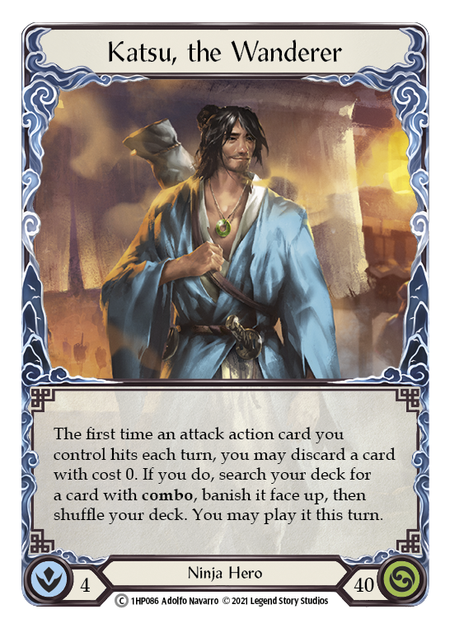
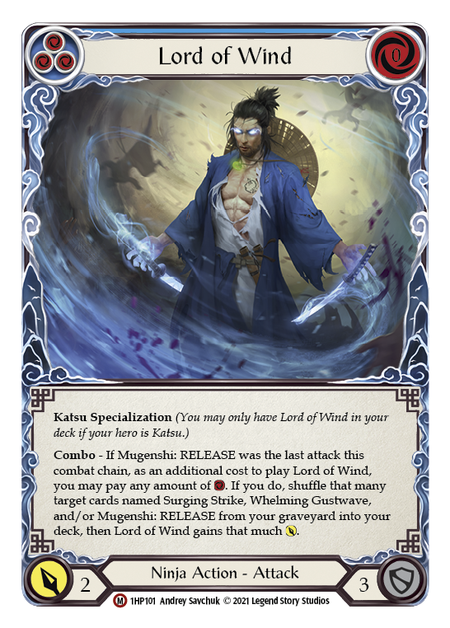
To illustrate this process, I’ll share my recent experience playing with Katsu. Since I was mostly trying Katsu for academic purposes, I started from scratch. I identified that the strongest thing available to Katsu is his Lord of Wind combo line. I made it my only combo line and my plan while setting it up was to leverage lots of three blocks and set up 2-card hands that could threaten Mask of Momentum triggers to slow my opponent down.
The results were poor. An opponent who blocked effectively could simply block the key on-hits and my 2-card turns were not threatening enough to demand armor.
I introduced the Blackout Kick line to have strong turns more reliably and tax armor. I still found the deck clunky though; I was getting more Mask triggers, but I lacked enough go again to reliably use the cards I drew. I introduced multiple go again effects to better compress hands. I found that presenting lots of go again meant that I got more chances to threaten Katsu triggers, making my deck much more consistent. This added consistency allowed me to add more power to the deck, cutting all the yellows and replacing them with the Fluster Fist line.
The end result, amusingly, uses almost entirely cards from WTR, making it look like a very simplistic deck. However, I now understand each card’s role within the deck; and come Outsiders, I’ll be well equipped to integrate new cards into my existing strategies.
Matchup Theory Development
Matchup theory is something I feel is frequently taken for granted in Flesh and Blood. Discourse is frequently as shallow as “block the on-hits” or “pitch stack your win condition”. In reality, matchup theory involves many elements like minimizing the impact of your opponent’s best turns, or navigating each turn without slowly falling behind. This is a gradual learning process with few resources to help you, depending on the deck you are playing. Even if you find a complete guide to a particular matchup, if your list is missing key cards, it may not work for you.
My method is like developing a narrative. After a series of games, I’ll take the most common turn cycles and stitch them together into a theoretical game and compare the outcome of that game to my experiences. Note taking and post-game reflection is very important here because reconstructing games from memory can be unreliable. Once I have a “script” that should reliably win games, I test it and make changes based on how it shakes out in practice.

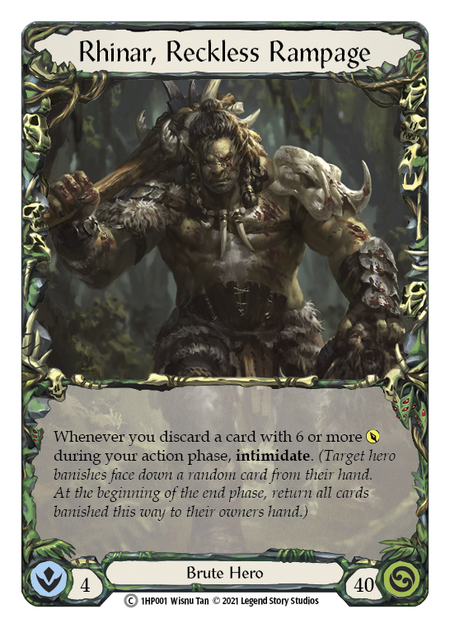
As an example, I’ll share how I developed my Rhinar vs Bravo theory. First, I started by comparing our win conditions. My win condition is resolving multiple Bloodrush Bellows over a game, each time attacking twice with Mandible Claws, and ending the chain with a big finisher like Savage Beatdown. Bravo’s win condition is repeatedly dominating disruptive threats like Crippling Crush. However, whenever Bravo activates his dominate effect only to have the crush prevented, he falls quite far behind. Naturally, I want a Sink Below in arsenal and to save my armor for preventing disastrous crush effects.
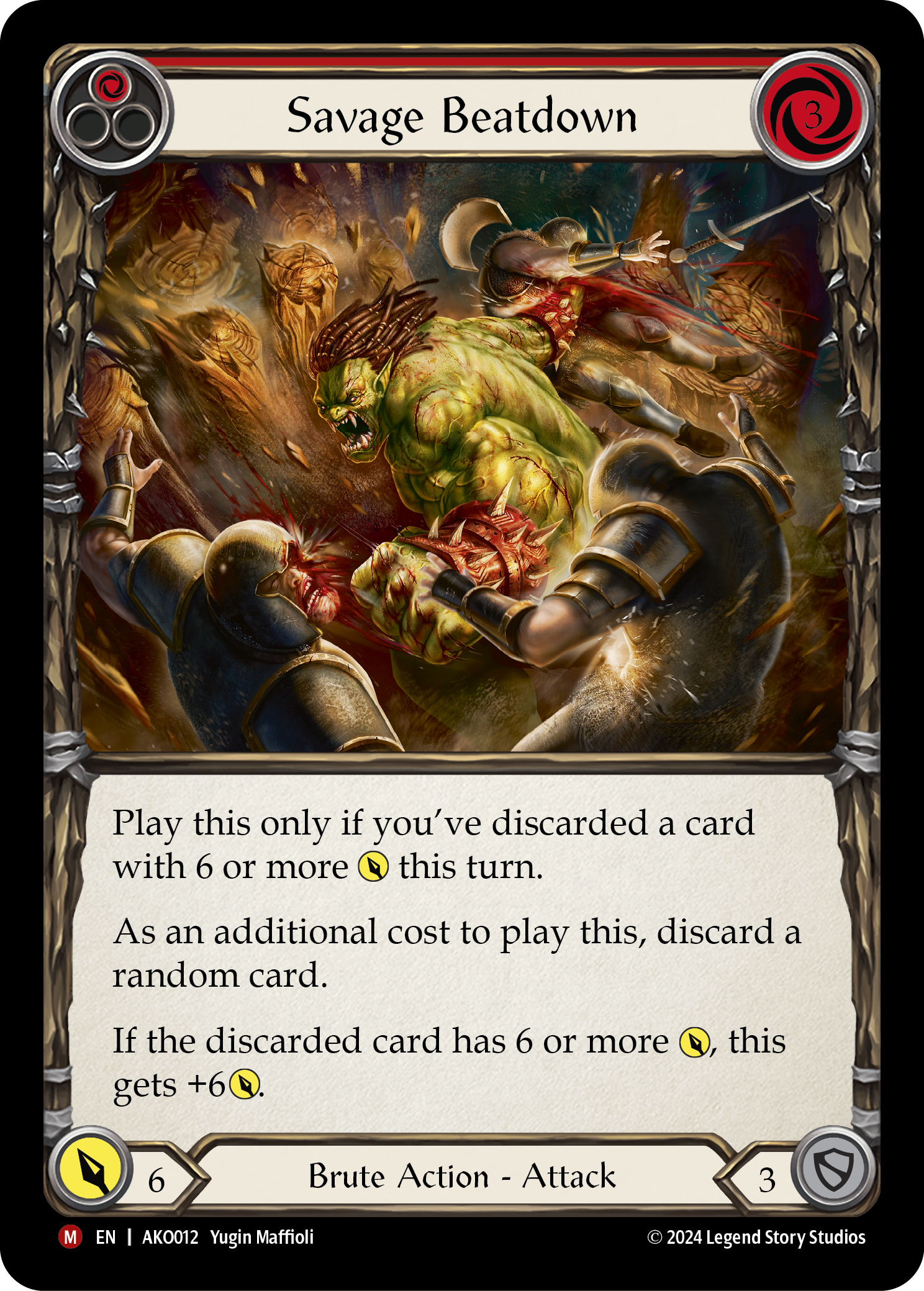
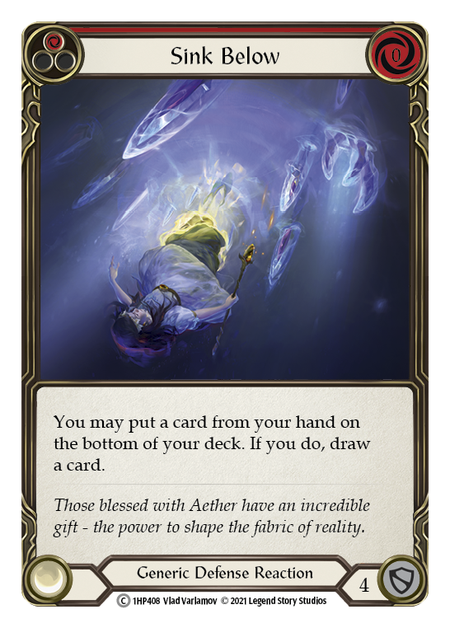
After losing a few games, I noticed a pattern. I was frequently unable to arsenal Sink Below because I was always arsenaling Savage Beatdown, which gets stuck there until I draw a Bloodrush. However, I also noticed that Savage Beatdown is the only card in my deck that is severely affected by Chokeslam (Chokeslam only affects action cards and not Mandible Claws). With Savage Beatdown in the deck, nearly every crush effect Bravo played had relevant disruption against a Bloodrush turn. Cutting it for this matchup gave me more flexibility in arsenaling Sinks and allowed me to dismiss Chokeslams.
Now that I had devised a strategy to resolve my win condition and defeat his, I was confident I had control of the matchup, but I was still losing games. Upon further review, I found I was losing many smaller turn cycles because of the interaction between the hand sizes we were keeping. My deck primarily plays 2-card hands while waiting for a window to Bloodrush. If Bravo dominates any attack, he limits me to blocking with 1 card, sticking me with 3-card hands I can’t reliably convert. If Bravo dominates an attack, I can usually only block for 3 and attack back for 6 damage. If he chooses to block with 1 card, then dominate another Chokeslam-like card, we have multiple turn cycles where I am taking 5+ damage and only dealing 3 because my last card is locked up in my hand. Many matchups are lost based on minor leaks such as this. My solution was to play Sigil of Solace and more non-attack actions with go again so I could do more with 3-card hands.
This process took a dozen games to develop, and extending this to any of the other matchups you expect to see at an event can be an intimidating prospect. However, every matchup you’ve developed a strategy into will yield rewards at a tournament. Before Outsiders, this might seem like a waste of time, but metas usually change slowly. New decks take time to develop, and people take time to learn them. Expect to still see plenty of Oldhim, Iyslander, and Fai at the top tables in the months following Outsiders and prepare accordingly.
Refining Play Patterns
Once you have a deck you are happy with and the strategies you need to win, you need time to reinforce what you’ve developed. Tournaments are mentally exhausting, and you are limited in how much information you can take into a game. Because of this, most turns in your deck should be affixed in muscle memory. Playing without over-thinking saves brainpower and speeds you up, which is essential during timed rounds. This requires playing many games over a long period.
It’s important to note that this shouldn’t be considered grinding. I find learning is best done in 1-2 hour periods interspersed with breaks - or better yet, sleep. If you play your deck for 2 hours, 3 times a week, you will likely see far better results than one 6-hour grindfest.
It is also essential that you are reinforcing effective lines, which may mean taking time away from actually playing the game. This can come in the form of watching streams and comparing your lines to those of high-level players, or watching recordings of your own games and taking notes on the results.
In any case, this is a time-consuming process which is why it tends to happen while I’m working on other parts of the deck. While I’m in the middle of a practice session, I’m always ready to switch gears and start analyzing situations I’m unfamiliar with – I never practice on auto-pilot.
Putting It All Together
Testing is a complex, time-consuming process, and what I’ve detailed here is only a survey of what works for me. Depending on your level of commitment to competition, you will have to adjust to your own needs. For myself, I play in 1-2 Armories a week, play 2 hours on Talishar 3 times a week, and I’ll spend an evening with my testing group on the weekend if we can arrange it. I give myself at least a month to learn a new deck, moving back and forth between R&D, theory, and refinement based on the notes that I take and feedback from my local scene. Our Vancouver team was a force at the 2022 Canadian Nationals, with 4 spots in the top 8, and we’re really excited to bring that into Outsiders starting with Pro Tour: Baltimore. See you there.
Background music is Lone Wolf | Prepare for War | Vopna | Now We Ride | The Road Home | all by Alexander Nakarada | Music promoted by Chosic | Attribution 4.0 International (CC BY 4.0)






